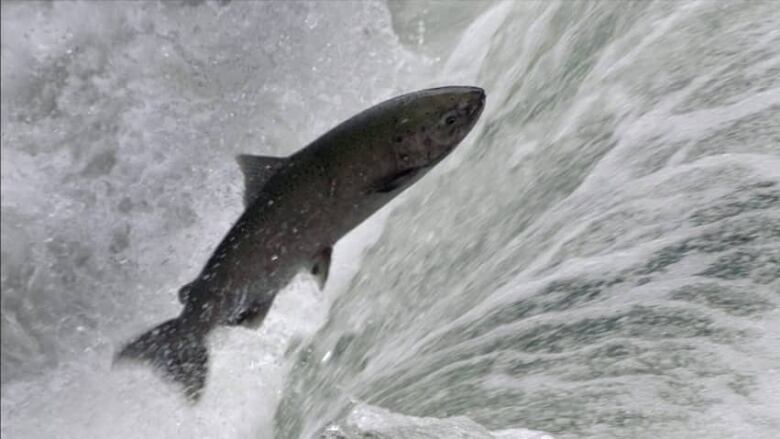Size limit on chinook salmon introduced to help fish blocked at landslide
80 centimetre size limit from July 15 to July 31 meant to allow more chinook salmon to get up Fraser River

The federal government will implement a maximum size of chinook salmon to be caught by recreational fishers in an effort to help the thousands of fish blocked at a landslide in B.C.
Since late June, thousands of salmon have become blocked at a waterfall west of Clinton on the Fraser River, following a landslide. The waterfall is blocking the fish from travelling upstream to spawn.
The federal government estimates around 2,000 fish are arriving at the barrier everyday, with that number to increase in coming weeks. Fisheries and Oceans Canada (DFO) says only a small proportion are getting through the barrier.
On Friday afternoon, the agency announced a measure to try and help keep as many chinook salmon in the river as possible.
Marine recreational fisheries are set to open July 15 for chinook salmon. Fisheries and Oceans Canada is placing a size restriction of 80 centimetres on fish that can be caught until at least July 31.

The agency says the measure will keep more larger at-risk Fraser chinook salmon in the river, improving the chances that more of them will get upstream.
The agency hopes that by July 31, most of the fish trapped at the barrier will have moved on.
DFO says it will also be working with First Nations in the areas to minimize chinook harvests above the slide site but admits that it was a difficult decision, considering how First Nations rely on chinook as a food source and for recreational fish harvesters.
The agency said the emergency is so great at the barrier that a permanent loss of chinook populations is possible.
Significant impact on First Nations communities
On Friday, Grand Chief Stewart Phillip of the B.C. Union of Indian Chief said that salmon is an integral part of First Nation's history, culture and traditions.
"This particular rock slide is going to impact a significant number of communities," he said.
He is calling on all levels of government to use all the resources available to find a solution to the problem as quickly as possible.
Phillip also supports a call from the Fraser Salmon Management Council (FSMC) to halt all recreational and commercial fisheries fishing Fraser River salmon stocks until all salmon gain access around the slide area.
We’re taking further action to address the critical threats of the natural rockslide at Big Bar BC to at-risk <a href="https://twitter.com/hashtag/FraserRiver?src=hash&ref_src=twsrc%5Etfw">#FraserRiver</a> <a href="https://twitter.com/hashtag/Chinook?src=hash&ref_src=twsrc%5Etfw">#Chinook</a>. <a href="https://t.co/GfoTadBSb4">https://t.co/GfoTadBSb4</a> <a href="https://t.co/3NOPGPbkVo">pic.twitter.com/3NOPGPbkVo</a>
—@DFO_PacificThere are 13 Chinook populations of salmon in the Fraser River. Seven of them are endangered and four are threatened.
During a news conference Friday afternoon, officials did not elaborate on plans to physically move trapped salmon around the barrier, but work is ongoing to try and assess how best to do that.